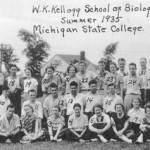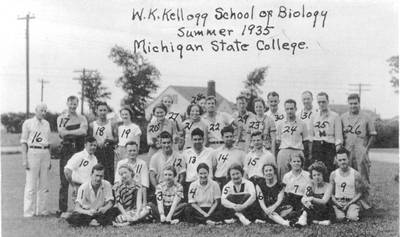
 A Summer School of Biology was held at the Farm and Bird Sanctuary from 1929 through 1939, with a one-year gap in 1933. The photo from 1935 that is shown here is the only one from the program that is known to exist.
A Summer School of Biology was held at the Farm and Bird Sanctuary from 1929 through 1939, with a one-year gap in 1933. The photo from 1935 that is shown here is the only one from the program that is known to exist.
The program was organized and headed by Joseph W. Stack, Professor of Zoology. He is No. 25 in the photo. The other faculty members were Walter F. Morofsky (No. 29) and H.T. Darlington (No. 16).
Facilities were meager. Students and instructors lodged, ate, and held indoor sessions at the Teachers’ Club House, a big two-story frame building on 40th Street that was used by teachers of the Agricultural School during the regular school year.
Stack described the early days in a brief talk he gave at the dedication of the Gull Lake Biological Station in 1954, twenty-five years later.
Although we had planned to start our Field Biology School June 23, 1929, we didn’t get positive authorization until two days before that date. The Staff members were Dr. Morofsky, Dr. Darlington, and myself. In two days we had to obtain beds, mattresses, cooking utensils, china — and what crockery — from Wells Hall; groceries and a cook. If it hadn’t been for the enthusiastic and untiring spirit of Dr. Morofsky and the willingness of Dr. Darlington, I’m afraid we would have been days late in opening the first Field Biology School. For ten years we went through the same procedure — never knowing until the last minute of registration whether we would have enough students to warrant having the School. However, the attendance did increase from eight students to a maximum of twenty-four from 1929 through 1939.
Stack may have taken literary license in describing the very first year, or perhaps he had compressed his memory of those days, because from other evidence in his papers it seems that he was the only instructor in 1929. He taught Field Biology, Zoology 303, Zoology 314, and Zoology 201, with one to four of the eight students in each class. No Botany class was held that first year. (Darlington was the Botany instructor in subsequent years, and Morofsky taught Entomology.)
The first year was also different in that lectures were held on the main campus in East Lansing. The students and instructor came to “Kellog’s Biol. Lab” for only two days for each of five weeks, arriving early enough on Friday to take three meals at the Kellogg properties, and returned late on Saturday. A night’s lodging cost 50 cents, and meals were 50 cents each. A typical bill for each student was $3.50 each week – for 6 meals and one night’s lodging.
But it seems that in subsequent years, the sessions took the form described by Stack in his 1954 talk. And it seems to have been true that it was touch-and-go each year as to whether there would be enough students to hold the summer session.
Sorry, the comment form is closed at this time.